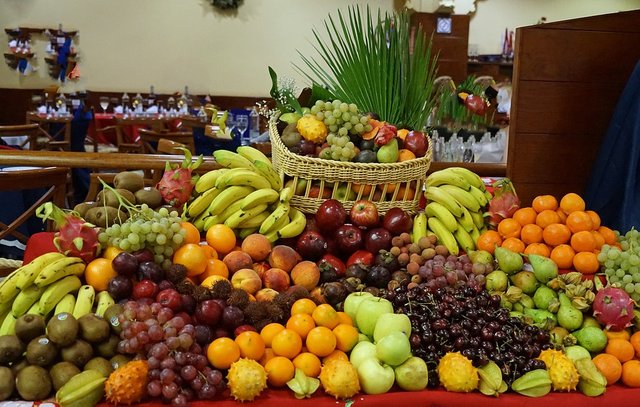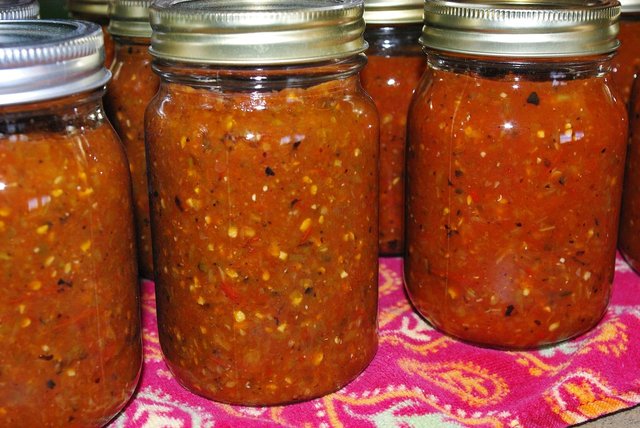Separating Content by Type: Making Steemit a Buffet and Not a Stew
To win in the attention economy, Steemit must make an important change


Image: Creative Commons, Flickr, Tim Patterson
Over the last three weeks, the Steemit community has tried some fun experiments with content. These have included launching or boosting some new tags: # til (Today I Learned) , # news, and # funny. In the last few days, # newslink has joined the party. The main goal of these experiments is not to dilute the quality of content on Steemit.
The goal is to prove that shorter content, and even pure links, can succeed here
And these tags have succeeded, at least for a period of time. The Reddit-style # til became the # 1 tag on Steemit for a brief time and has spent much of the last few weeks in the Top 5 space. Launched on the same day, # funny has taken longer to gain a foothold, but is in the Top 5 at the time of this writing. # newslink also has been climbing into a high position.
Long articles have not been enough to get Steemit off the ground. Long-length content gives us a site like Medium, which is a good quality platform, but it limits us to attracting only the people who like to read or write long content. If we want Steemit to grow, we must recognize that 90% of our target population doesn’t have the time/patience to read or write long articles.
That means we need a place for shorter length content, not to replace the high quality material, but to supplement it. We must accept shorter length posts, perhaps 1-3 paragraphs in length. And we also should accept links.

The Reddit site has tens of millions of users. And it’s basically just a site where people go to paste links with short titles. Facebook, Reddit, Twitter, and other social media sites reward people for linking content that “goes viral”. Except that those sites don’t pay people like Steemit does.
What if we could do what they do AND pay people for it?
But there’s a problem. And it’s making the diversification of content very difficult.


Why # til is Falling Quickly
After peaking at the # 1 position, the # til tag is falling. Soon, it will drop out of the Top 10 tags. Why is this happening? Is it because people have become bored with TIL already?
I don’t think so. Reddit’s TIL sub has been very popular for years now.
The short answer is that the content in Steemit’s # til has turned to shit. And the content is # news is even worse. There are still some very good posts in each tag, but the quality and format have become extremely variable.
How did this happen so quickly? I see two main reasons.
(1) Authors multi-tag their posts. What begins as a pure link within # newslink does not stay there, because people submitting posts are tempted (encouraged?) to add additional tags when they submit, up to five per post.
So a submission in the # newslink category also might have a # news tag along with something more specific like # food or # sports. When one post gets rewarded, others follow, and suddenly a tag like # sports may end up with a bunch of sports-related links, though these would have fit more squarely in # newslink only.
(2) Steemit has no real rules. Yes, @cheetah is out there spotting plagiarism and Steemcleaners has done a great job keeping the site tidy (thanks @anyx !). But short of plagiarism or spam, anything goes. We only have two tools for curating posts: we upvote/reward them or we flag them (in rare cases of spam or abuse).
Generally, Steemit’s curators are not heavy-handed. Flagging a post has very negative consequences for the author’s reputation. So curators are not flagging posts that fail to conform to format guidelines. Because a # sports post may be upvoted/rewarded by sports enthusiasts, it also will rise in another tag that is used, such as # til .
And so the only two methods of curation which we have available (the upvote and the flag) are both impossible to use effectively in maintaining tag “integrity”. All we can do is let the community and the market do what they will with the tags. It’s fascinating to watch this evolve, but often the tags end in a mish-mash of content and formats.
Also, there is no place to “sticky” any rules within a tag, as Reddit does within its /r/ subs. I like the fact that we don’t have rules. But how can we expect new users to understand ‘unwritten’ rules? We can’t expect that, so we do not flag them when their posts do not conform to ideals.
As a result, a tag like # til cannot maintain its integrity for very long. Three weeks ago, we began testing that tag with the simple model format of a 1-2 paragraph post + a link. Instead, people submitting posts in other tags (such as # sports, to take an example) began to notice that # til is a top-rewarded tag. And because a sports author believes his/her post is an informative one, that author may multi-tags it with # sports and # til (most people are using more than two tags). So pretty soon, the original # til format is lost. It just becomes another random tag that people add to every post for a while.
Unless it’s something clearly different like # photography, there’s nothing distinguishing about the posts that use a tag anymore.
So Steemit Becomes a Stew, Too
What we need on Steemit is a diversity of content where people can quickly locate and interact with their favored content area. Topical tags are not enough. They are not getting this job done.
We need long posts, short ones, pure links, FAQs, Wikipedia-type articles, videos, music, and much more. If I go to a buffet, I want different foods on different platters, clearly recognizable. Yes, people are being paid to curate Steemit, but there’s a difference between cleaning up a desk top and a garbage dump. Most don’t have the time or patience to pick through a stew to find their favorite bits of food.

If we build it, they will stay when they find it. When we have all (or even a few) of those clear types of content functioning well, the site will be attractive to people who come here for those different reasons. They will find something they like here right away. We will grab and hold their attention and participation.
But we’re not allowing that right now. Yes, we have the tags, but as I showed above, they aren’t very effective at delineating content. And that is especially true when the content is of a different type (e.g. a link or a video) rather than just a different topic (like history or sports).
What we’re doing is inviting people to Steemit for the sausage, but then throwing that sausage into a steeming stew full of vegetables, grains, meats, and everything in the kitchen sink. You came here to eat sausage? Sort through the stew pot and find it yourself. Hope you like vegetables, grains, conspiracy theories, photography, SteemSports, and openmic also.
And the only people who stick around are the oddballs (there are a few of us) who actually do enjoy or have the patience to sort through the whole spectrum of content. We'll eat stew or drink smoothie; others come for something more specific.
For all other potential users, we fail miserably to grab and hold their attention.
How Steemit Can Win in the Attention Economy
Give them what they want and let them sort/curate within that area. These last few weeks, all we have proven with these recent tag experiments is that the community will welcome different kinds of content. And that was an important step.
But we lack any way to maintain the separation or integrity of those different content types, unless they are something so obviously distinct in type and topic (e.g. photography) that a tag can be a more effective separator.

Some people come here to paste links, so let’s give them links, but they shouldn’t have to sort through thesis-length articles, photography, and other types of posts to find those. YouTubers come here, but they often leave quickly because we have no established place for video. Shouldn’t we have that? If we decide that there should be another Steem-powered site/layer/app that handles video, and not Steemit.com, that is fine.
But if we want Steemit to be the hub for all content on this blockchain, then we need to make that content visible and easily accessible for people.

Image: Public Domain
Separate Content by Category
There might be other ways to solve the sausage stew problem. First, we could force authors to choose just one tag at submission, and narrow the content that way. Second, we could come up with some lighter-handed tool for curation, something less than a flag but somehow strong enough to discourage non-conforming content in a particular tag. But both of these “solutions” are limiting and both would lead towards more aggressive moderation, which may not be the direction we want to go.
I think the better solution is to separate the content on Steemit by type.
When people come to the site, they should see clear, separate areas for different types of content: long posts, short ones, pure links, FAQs, Wikipedia-type articles, videos, music, and so forth. Those types of content should be whatever Steemit.com wants to present. If Steemit.com wants to leave some type of content (e.g. music) to another Steem-powered site, then Steemit.com would choose not to compete for users’ attention in that particular content type.
Within each content type, people would still see the topical tags. For example, when they click on video, they would have a choice of videos in tags such as # animals # birthdays # WTF and so forth. Like different flavors of gelato.

Should these different content types be formalized on the blockchain or simply presented in a more organized way on the site interface? That answer is above my pay grade. I am just a content person, so others can debate those more difficult questions. Having worked on the content here as an author and a curator, I can say quite honestly that we have some work to do on the site if we want to compete in the attention economy.
And the easiest way to excel at this is to give people what they want. Steemit should be a buffet of diverse content in clear locations, not a kitchen sink stew of everything they want (and do not) want mixed together.
I think that implementing this change would set Steemit up as a clear alternative to Reddit, Medium, YouTube, and a lot of other content sites. If we want peoples’ attention, we can get it and we can keep it. Doing so would launch Steem into the stratosphere and make this the “go to” place for content.

All images from Pixabay unless noted.
Very well said. We are just in the beginning stages of building out our platform. The cool thing is we have a community that will eventually agree how our content is presented now, and in the future. Let's have some fun with this.
Yes! And sometimes that slow evolution needs a little nudge.
Great article and I completely agree. Dividing steemit into sections will make a huge improvement in usability.
divide and conquer! :)
I agree totally. I think to sum it up, I would say that we need better organisation. Period.
Also, when a site is new, there is not much content TO organise. But now, there is a healthy amount of diverse content and it is high time that we address this issue.
It's like organising your media at home. You've got movies that all go in one place, music CDs(?) that go in another, books that go on a shelf, photo albums that go on another. And when we want a particular type of media, we can just go to that particular shelf and then search for the different genres under that section!
We just need to tidy up our Steemit house. Build some shelfs and put the diverse content in it's respective place!
To me tags have always been more about the theme of a post rather than what form the content takes, and it seems natural to interpret them thus. So your idea makes a lot of sense to me. Keep the tags in addition to sorting by content type (video, music, link, essay, etc).
Sounds simple, but the main problem is how to enforce the separation of content. You can't just slap on a video section, and then have people submitting written stories there instead of videos. To be effective, the site's UI should naturally limit content to the appropriate type. For example, to submit a link you would paste the link into a form, and maybe fill out another box on the form that allows, say, 255 characters to describe your link. And that's it. These restrictions would also have to be enforced at the level of the blockchain API, to prevent bots from bypassing the rules. Not sure if the structure of the blockchain itself would need to be changed, probably not as long as the APIs are the only onboarding point for content, and there was some schema for interpreting data properly when it's read off the blockchain.
This would go a long way toward improving Steemit. To some extent my carefully cultivated feed acts as a nice strainer to pluck out the meat I like, but it's a lot of work sifting through stuff in the first place to find the right people to follow, and it's not perfect (especially with all the random stuff that gets resteemed these days).
Excellent article @donkeypong! Thank you! We have been talking much about curation lately and few about content. A classic chicken-egg-error. Because before wondering about how to perfectly allocate votes and get rewarded for them, we should make sure there is good and nicely structured content on which to vote.
I am totally with you: for new users it's very hard to find a way through the jungle. You say that we have unwritten rules. Why don't write them down? And why don't limit tags to a maximum of 2? At least for some time to see if things would get better. No matter what your story is about I bet you will be able to perfectly tag it with two trendy key-words.
I also totally agree on the structure problem. It would be awesome to have a sort function. Like this the system wouldn't be defining a universal structure for everyone but offering an individual structuring tool.
Moderation is good but will require a lot of resources. I am not sure if we could provide them at this point of time. And a network which aims to become a mass medium in the future should have an excellent and easy to understand usability in any case. If we needed people to guide the traffic the system wouldn't be able to handle masses.
I agree 100%. Foodcourts at malls succeed ... and give individuals what he/she wants. They even succeed when they are right next to more upscale restaurants. The idea of TIL and News wasn't to replace longer posts, it was to add to them. They give people more of a choice based on his/her preference. That is exactly why I love them. My preference changes minute by minute depending on what else is going on at that moment. Sometimes I have time for checking out some long posts, sometimes I just want to hit some interesting material during a quick break. The same goes for writing and providing content. Sometimes you feel like a nut... sometimes you don't. (I usually do).
I don't think it is should be divided strictly by type, but I do think that separate categories, like reddit (which can each enforce their own rules) should be implemented. For example, a news category may include links, or pictures, or articles, as long as they are about news. On the other hand, some categories may implement strict rules about type.
The biggest problem with organization currently is multi-tagging. When TIL became popular, authors starting adding TIL as secondary tags, and their posts would show up in TIL as well, even if not at all, even if not conforming at all to the (unenforced) expectations of the TIL section. That quickly made the TIL section reader-unfriendly, leading to a decline in popularity.
If the content were organized by type, then the submission editor could serve a gatekeeper function in terms of requiring a video in the video category or limiting the number of characters in a post, etc. Yes, it would be fine to have mixed content and overlap for certain categories. What you're suggesting might require more intensive curation within categories or tags. I am not against this, but it is a big job, so we need to think about how the market would incentivize that that sort of gruntwork also.
I don't disagree but as I said above the biggest issue is how multiple tags are handled. If people can just throw in TIL as the fifth tag on their post because TIL is popular, even if it is the right type that is still going to make TIL useless.
I agree. I'm not sure what the best approach is with the tags, but glad we are having this discussion and getting people thinking about it.
food definitely needs it's own content type separate from everything else, as I do not like to read about food, and there is so much of that on steemit
Apparently, I picked the wrong metaphor to use for my post, then!
Please use a different word or explanation here:
That's not how dilution works. If you add water to oil, you dilute the purity the oil was at. If you have 100 posts of long content in one place, and you add 1 post of short content, the "purity" of long content in one place gets diluted by short content. That's simply reality. Just to make things more clear and defined.
Well actually, it's whatever the whales upvote and generate popularity for that many of the community users will support. If no whales (a small minority of the actual majority of the community) did not upvote these new post types, they would not be successful. It's not the "community" at large with low SP that makes these posts a success, but the whales that makes these posts a success with payout that draws more attention to the post, and thereby garners larger community support. Try an initiative without whales support, and see how long it last lol.
And the issue with all these content types, is with labor and reward. Time, energy and effort goes into to make well written pieces, art, and other content. Rewarding people from the same reward pool, for doing hardly any work, taking hardly any time, putting in hardly any effort, copy/pasting, and they get to reap rewards for sharing work other people did, rather than create work of their own. In the end, different content types require their own pool, platform or coin to create a value reflected in a currency base don specific content type. That way if something sucks but is only riding the tail of success in the overall platform and getting whale upvotes to success, then the rest of people don't have to get the potential rewards they make for lots of time, energy and effort, get sucked up by people who just copy paste and don't put in the labor to create valued content on the platform.
This way, a platform/token focused on created actual content, taking time, putting in energy, laboring to produce something real and have it valued, can actually be worth more, than another platform that doesn't create content, that simply copy pastes links or content to try to make money without putting in any real work. Then you would objectively see what has real value in a society. Original content creation vs. rehashing links and copy/paste. The quality of the community in the former platform would blow away everyone in the latter. Quality platforms matter to attract people.
Build the quality, and then quality will come. Build low quality, and you just get more low quality quantity of people that don't help to elevate the overall quality of the platform.
Thanks. Peace.
There is effort related to posting links too, as it requires to surface the respective content from the web. Having said that, I obviously agree, that the effort for posting links is much lower compared to generating primary content. So why not reflecting this with different payout schemes for the different content categories? Author rewards for link-postings could be at 10% of normal payouts and still make this a very attractive category, I´d assume. I made a proposal about this three of months ago.
Yeah, a different payout is 100% required. Time, effort, energy, labor, work to create content VS. no time, no effort, no energy, no labor, no work to copy/paste a link. Obvious difference in labor-value ratio.
The difference in labor-value will be handled automatically by competition. If links are overrewarded people will post more of them, and fewer and fewer will gain votes. Either the quality (and timeliness) required to be rewarded will go up, or it will become somewhat random, with those who post a link and win the raffle rewarded, but most who post links will not be rewarded much if at all.
Or. People will post more and more in an attempt to merely get lucky. Because its really not that hard to post 100 or 1000 links or 10000 links, even if you're making sure that your links are somewhat topical, there are a ton of link aggregators out there. It wouldnt be hard at all to find 20 or 30 sites like coin telegraph and link every single news story that comes out of them.
Even if this task could not be automated diretly with a bot of some sort (and i strongly suspect it could), there are already a ton of windows automation programs that would bring the compatative amount of effort to practically zero.
And even if the labor differential was not huge, there is another problem. The people who cannot make money writing "long content" (either because theyre bad at english or because they have nothing to say or whatever) are still offered a better hourly by link spamming.
That is to say that the raffle ticket we offer link spammers, for at least some of them, is the their highest hourly EV option. SO why not gather as many raffle tickets as possible.
Posting the links is kind of useless. They need to get votes. Probably the most successful link posters will be voting their own links to give them at least minimal visibility, which means vote power becomes the limited resource, and those doing it will will need to be selective.
Beyond that, even posting the links themselves requires bandwidth, which requires SP. So those wanting to compete by posting links will need to buy more SP, both limiting volume and driving up demand for SP.
You call that a "problem". I call it an opportunity to be more inclusive. Instead of shutting out people with weaker english skills or less captivating personalities, I'd rather have a system them offers them opportunities as well.
Posting a link is not effortless. Even to vote for a post on steemit with a single click is not effortless. It requires time to identify good content.
(Sure you can drop random links and vote whatever your mouse pointer accidentally finds, but such effortless strategies would not lead to relevant rewards, I´d say.)
One of the reasons (probably the main reason) that posting un-commentated links is now frowned upon is that this is exactly what happened
Really? I haven´t observed that. I haven´t seen many un-commented link-posts at all and I don´t recall any with a significant payout. Do you have examples?
I see that you clearly understand the fallacy of your own argument, having used no less than five tags. Why did you do that? To gain the widest possible audience for your post. Way to make stew while advocating for buffets. What's good for the individual is good for the platform. Just vote your preferences and let it work itself out. We keep trying to manipulate this thing and I feel the whole downfall of the price of Steem started with the asinine idea that every single post deserved reward. We split it and split it and split it, until only posts from groups splitting rewards get any. No one who is interested in being a serious content producer is interested in that model. Period.
Making my point. If you go back and look at my posts, I often pick no more than two tags.
But, you understand why the rest of us think that's bullshit, because when you want to reach the widest audience, you use five. That's what's known as hypocrisy.
It was two main tags. Steemitideas and buffet had nothing in them; I checked before submitting. The latter was for comedic value anyway. It was tagged accidentally in # newslink, since I forgot to add a space in the text when I was discussing this. So just two main tags; the rest is for illustration purposes only. Again, I rarely use more than two tags per post, sometimes three.
Rewards should be proportional to the work or the informational/entertainment value. The market and community can handle that one, I think.
entertainment value is way more important than amount of work, in terms of attracting a larger audience
I hope the people Steemit attracts would avoid or ignore copy and pasted links. So far, I haven't upvoted any links or link based postings. I get enough of that on FB. I have some faith that original art - writing, music, graphic art - will attract more people and get more upvotes than a link. Fingers crossed. Enjoy the day!
Oddballs?
I resemble that! ;)
I'm not sure what the solution to the problem is either... But I'm certain there are enough of us oddballs on Steemit to figure it out - eventually.